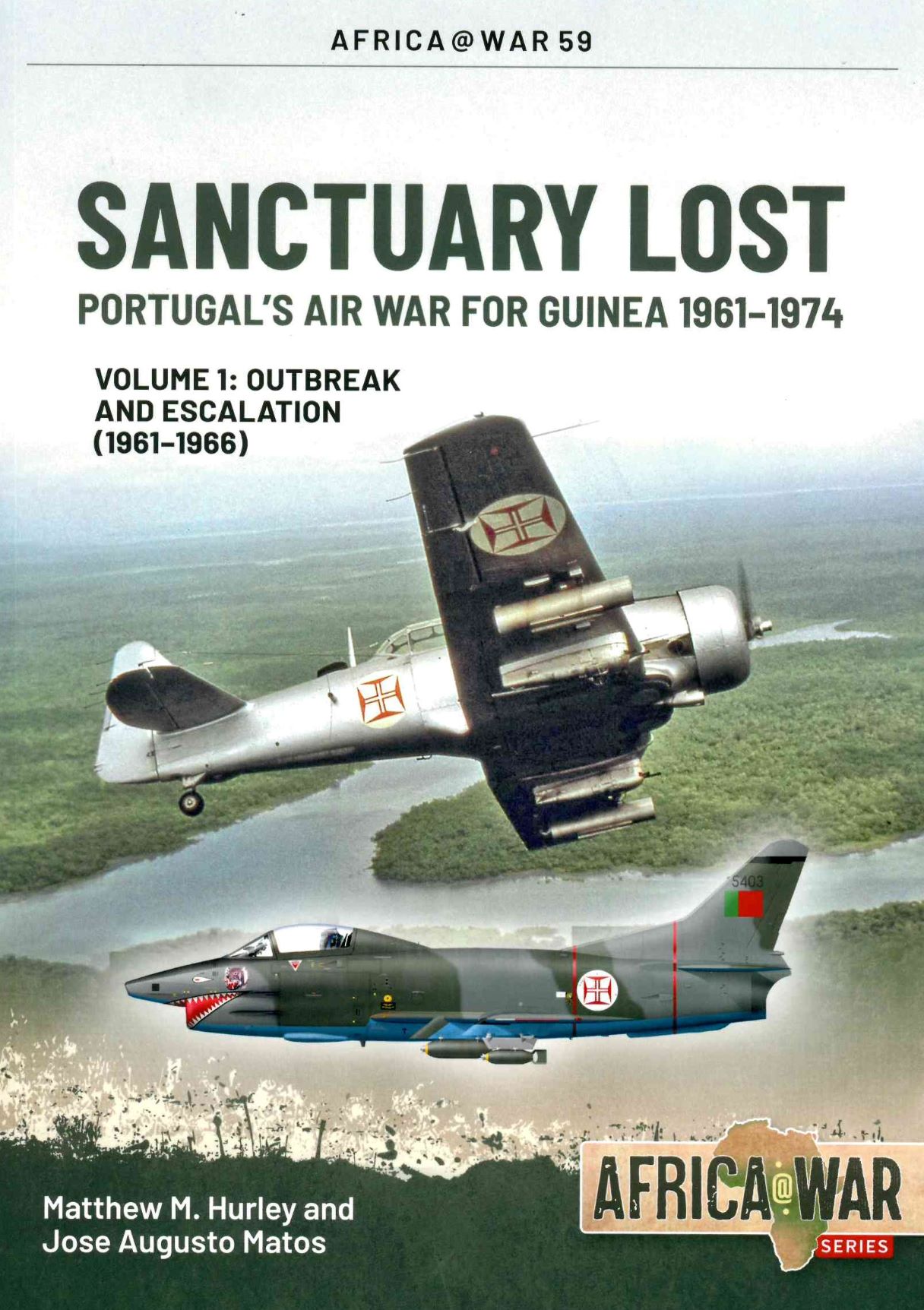Sanctuary Lost, Portugal's Air War for Guinea 1961-1974, Volume 1
Reviewer’s Comments:
“- I also want to go fishing, Uncle Aliu!
You cannot, Abdulai, because it’s dangerous.
Uncle, I’m not afraid of the crocodiles!
You know, now there aren’t just crocodiles,
There are also the colonialists who drop bombs on the canoes,
[but] I cannot fear the crocodiles or the bombs.
This is my mission, as a militant of our Party.”
Thus opens the introduction of book, in the aptly named Introduction: Crocodiles and Bombs. Each chapter opens with a great quote that ties in with the chapter name – kudos to the authors for this additional nice touch. This book, while it covers Portugal’s war in Guinea (now Guinea Bissau, and not to be confused with the Republic of Guinea) is primarily focused on the Portuguese Air Force (Força Aérea Portuguesa-FAP) in its operations in Guinea supporting the counter-insurgency.
The authors do an outstanding job setting the book up from the beginning with military terminology, the FAP’s organization, planes, background of Portuguese colonies (eloquently called “overseas provinces” or simply “Overseas” (Ultramar) – which comprise of Guinea, Cape Verde, São Tomé and Príncipe, Angola and Mozambique in Africa; the Atlantic colonies of the Azores and Madeira; Brazil; East Timor (Southeast Asia); Macau (China); and Diu, Goa, and Damão in India). This book is as much history of the former Portuguese Empire and the anti-colonial forces who fought for independence that came to a boil in the 1960s, aided by the Cold War.
While relatively unknown to most of the world, the FAP was an amazing organization that was adaptable and improvised solutions in a relatively quick timeframe, transforming quickly to persevere in sustaining Portuguese strength scattered throughout some of the most inhospitable terrain on the planet. The War for Guinea also experienced some insurgent firsts - the first use of guided missiles , and the first use of what would become the most widely produced and deployed air defence missile in the world. On the FAP side, helicopters came into their own based on French experience in Algeria and the British in Malaya; close air support by both prop driven and jet aircraft (neither designed for their new roles) was perfected; and a remarkable logistics system was developed.
The Guinea War is even more remarkable in context to Portugal’s other “Overseas” possessions, as highlighted by the authors,
In terms of land area, the territory occupied approximately 36,000 square kilometers – slightly larger than Belgium, and only three percent of Angola’s acreage – bounded by 680 kilometers of land frontiers and 350 kilometers of Atlantic coastline. Only a tenth of that land was arable with the rest heavily forested, laying in permanent swampland, or flooded by the high tide and lengthy rainy season. Since the abolition of the Atlantic slave trade the territory had become a net liability on the Portuguese treasury, of interest to only a trio of corporations that wrung a modicum of profit from the cultivation of groundnuts and palm kernels. “If Angola developed as the jewel of the Portuguese empire,” one contemporary Portuguese author observed, “Guinea was never more than a scrap of brass.”
Additionally, Guinea had only 60 kilometers of paved roads, the land was crisscrossed by extensive rivers and streams, and the Atlantic tides would routinely flood much of the territory up to 100 kilometers inland, leaving mudflats in their recession. Thus, most of the province was inaccessible to armored, mechanized or large infantry forces.
The book is presented with photographs of the key leaders, aircraft, ships, operations, maps, tables, a color profile section, the introduction (which I usually don’t note except this title is Crocodiles and Bombs), and the following five chapters:
- The Wind of Change
- Planes of the Cross of Christ
- The Friendly Shade
- Eggs of Fire, Eggs of Death
- They Have Only the Sky
The books two authors are well credentialled to write this book. US Air Force Colonel (Retired) Matthew M. Hurley served as an intelligence officer and on the Tactical Leadership Program and Air Command and Staff College and has published numerous articles on airpower history and campaign analysis. José Matos is a Portuguese military history researcher focusing on the Portuguese Air Force during the African colonial wars, especially in Guinea. Both have regularly contributed articles to history and military publications; this is the first of the @War series for both. Volume 2, Sanctuary Lost, Portugal's Air War for Guinea 1961-1974, Debacle to Deadlock, 1966-1972 is due to be published in May 2023.
Modelers and historians will enjoy this book with color illustrations and photos (black and white and color) images of Auster D-4/108, Do-27 “DO”, C-47 Skytrain/Dakota, F-84G Thunderjet, F-86F Sabre, P2V-5 Neptune, MH.1521 Broussard, T-6, S.E.3130 Alouette II and III helicopters, G.91R-4 “Gina”, amphibious landing craft, and combat photographs on the ground, in the air, and on the water. There are fantastic candid photos showing conditions experienced by both sides of the conflict.
This is an informative and motivating book covering another little known Cold War/African Colonial War campaign that is a welcome addition to modelers and historian bookshelves. This is especially a boon for anyone wanting to build a model of the Cross of Christ Air Force in the 1960s. While the G.91R-4 doesn’t make its combat debut in this volume, there are great photographs of them in their livery. I am looking forward to continuing this story in the second volume.
Profuse thanks to Casemate (https://www.casematepublishers.com) and IPMS/USA for providing the review sample.














Comments
Add new comment
This site is protected by reCAPTCHA and the Google Privacy Policy and Terms of Service apply.
Similar Reviews